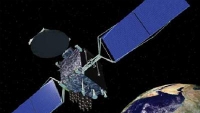Rogue satellite threatens cable programming

A wayward TV communications satellite — drifting out of control thousands of miles above the Earth — threatens to interfere with cable programming across the United States, said Intelsat, the satellites’ owner.
Intelsat said it lost control of the Galaxy 15 satellite on April 5, possibly because the satellite’s systems were knocked out by a solar storm. As a result, it cannot remotely steer the satellite to remain in its orbit, and Galaxy 15 is drifting toward the adjacent path of another TV communications satellite that serves U.S. cable companies.
Galaxy 15 continues to receive and transmit satellite signals, and will probably overlap and interfere with signals from the second satellite, known as AMC 11, if Galaxy 15 drifts into its orbit as expected around May 23.
AMC 11 receives digital programming from cable television channels and transmits it to all U.S. cable systems from its orbit 22,000 miles above the equator, SES World Skies, the owner of AMC 11, said. It operates on the same frequencies as Galaxy 15.
“That fact means that there is likely to be some kind of interference,” Yves Feltes, a spokesman for SES World Skies, told The Associated Press. “Our aim is to bring any interference down to zero.” He would not name any of the cable television channels or providers that could be affected or say how long the interference could last.
Galaxy 15 is floating over the Pacific Ocean slightly to the east of Hawaii, said Emmet Fletcher, space surveillance and tracking manager for the Space Situational Awareness Programme at the European Space Agency, an 18-nation consortium. He told the AP that Galaxy 15 was highly unusual because it continues to send out television signals, unlike other malfunctioning satellites that automatically go into complete shutdown when their navigational systems malfunction.
Feltes, the SES spokesman, said one option to prevent interference with U.S. television would be using AMC 11’s propulsion system to shift that satellite about 60 miles away to an orbit that’s still within its carefully prescribed “orbital box” but as far away as possible from Galaxy 15. He said SES had other strategies under consideration, but declined to provide details. “We have all of our technicians, all of our specialists on this case,” he said.
Get the TV Tech Newsletter
The professional video industry's #1 source for news, trends and product and tech information. Sign up below.
